FIELD VETERINARY REPORT FOR TSAVO MOBILE VET UNIT FOR THE MONTH OF SEPTEMBER 2014 INTRODUCTION: The Month of September witnessed a big increase in the number wildlife treated as compared to previous months of the year
FIELD VETERINARY REPORT FOR TSAVO MOBILE VET UNIT FOR THE MONTH OF SEPTEMBER 2014
INTRODUCTION:
The Month of September witnessed a big increase in the number wildlife treated as compared to previous months of the year. Case increase was mainly observed in elephant bulls injured by use of arrow shots in unsuccessful poaching attempts. The drastic increase is associated with the dry spell that forces wildlife to travel for long distances and sometimes outside the park in search of water and forage. Many of the injuries reported occurred in Satao, Aruba and Ithumba areas and involved mainly huge bulls. During the Month an elephant orphan was euthanized after sustaining a grievous injury from Hyena attack at the Ithumba stockade and a lioness was collared in Kuku ranch to aid in human-wildlife conflict. Rains are expected soon and vet case load expected to decrease as more wildlife utilise more the secure boundaries within the park.
Case #1: Treatment of an elephant bull
This report describes case intervention of a male elephant at Satao area - Tsavo East National Park. These cases were attended on Sky Vet initiative.
Date: 1st September 2014
Species: African Elephant (Savannah elephant)
Sex: Male
Age: Adult
Location: Satao area - Tsavo East National Park
History:
This elephant was living in a family of 7 males.
Immobilization:
Etorphine Hcl(0.98%) (M99®) (Norvatis South Africa (Pty) Ltd) 18mg, in a 3 ml Dan - inject dart was prepared. Helicopter darting was carried out. The first dart bounced off. We decided to do vehicle darting which worked well. Using a Dan inject® dart rifle (Dan-inject APS, Sellerup Skovvej, Denmark) the elephant was darted; he was immobilized after 10 minutes.
Examination and Wounds management:
The elephant had sustained a penetrating wound with sharp edges made by an arrow head which had dislodged off. This suppurative wound was cleaned and lavaged with copious amounts of water and tincture iodine to remove pus and mud, and then liberally lavaged with dilute hydrogen peroxide. Oxytetracycline spray (Alamycin® spray) (Norbrook Laboratories Ireland) was also applied. The wound was also covered with green clay to promote faster healing. The elephant was injected with Oxytetracycline 20000mg (Alamycin® LA 20%Norbrook Laboratories Ireland) i.m
Animal care during anaesthesia:
Animal was doused with plenty of water and the eye covered with the use of the bulls ear.
Reversal of anaesthesia:
Using 60mg of diprenorphine Hcl (Norvatis South Africa (Pty) Ltd) given IV at the ear vein the animal was reversed from anesthesia, (a ¼ of the dose was given i.m). We assisted the elephant to stand up. Recovery was good.
Case #2: Treatment of an injured elephant bull
This is a second case handled by the Skyvet initiative.
Date: 1st September 2014
Species: African Elephant (Savannah elephant)
Sex: Male
Age: Adult
Location: Satao area - Tsavo East National Park
History:
This elephant was living in a large family. We followed this elephant to a water hole.
Immobilization:
Etorphine Hcl(0.98%) (M99®) (Norvatis South Africa (Pty) Ltd) 18mg, in a 3 ml Dan - inject dart was prepared. Helicopter darting was carried out. Using a Dan inject® dart rifle (Dan-inject APS, Sellerup Skovvej, Denmark) the elephant was darted; he was immobilized after 10 minutes.
Examination and Wounds management:
Examination of elephant showed a huge swelling filled with pus on the left flank extending from the side to the inguinal area. The abscess was lanced and drained. The suppurative mass was cleaned and lavaged with copious amounts of water and tincture iodine to remove pus and then liberally lavaged with dilute hydrogen peroxide. The cavity was also lavaged with i.v fluids (Normal Saline and Ringers Lactate solution) Oxytetracycline spray (Alamycin® spray) (Norbrook Laboratories Ireland) was also applied. The surgical wounds were also covered with green clay to promote faster healing. The elephant was injected with the following,
- Amoxicillin Trihydrate BP 30000mg (Betamox® LA Norbrook Laboratories Ireland) i.m
- Flunixin meglumine 2500mg ((Norbrook Laboratories Ireland)) i.m
Animal care during anaesthesia:
Animal was doused with plenty of water and the eye covered with the pinna of the ear.
Reversal of anaesthesia:
Using 60mg of diprenorphine Hcl (Norvatis South Africa (Pty) Ltd) given IV at the ear vein the animal was reversed from anaesthesia, (a ¼ of the dose was given i.m). Recovery from anaesthesia was smooth and he limped away from the site.
Prognosis of the case:
Guarded
Case #3: Treatment of an elephant bull
Date: 5th September
Species: Loxodanta Africana (African elephant)
Sex: Male
Age: Adult
Location: Power line, Tsavo east
History: The elephant was spotted with fresh arrow wound on the side of the body by DSWT aeroplane near Aruba-sala road adjacent to the power line.
Immobilization:
Etorphine Hcl(0.98%) (M99®) (Norvatis South Africa (Pty) Ltd) 18mg, in a 3 ml Dan - inject dart was prepared. Helicopter darting was carried out. Using a Dan inject® dart rifle the elephant was darted; he was immobilized after 10 minutes.
Examination and Wounds management:
The protruding arrow head was removed and the fresh wound cleaned using water mixed with hydrogen peroxide. Oxytetracycline spray (Alamycin® spray) (Norbrook Laboratories Ireland) was also applied. The surgical wounds were also covered with green clay to promote faster healing.
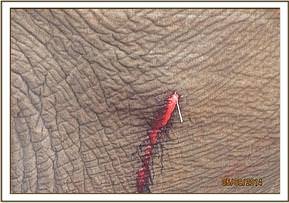
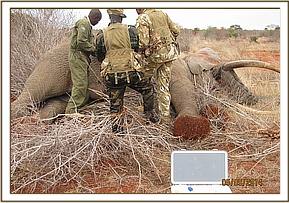

The elephant was injected with the following,
- Amoxicillin Trihydrate BP 30000mg (Betamox® LA Norbrook Laboratories Ireland) i.m
And colvasone (Dexamethasone) administered i.v
Reversal and prognosis:
The anaesthesia was reversed using 54 mgs of diprenorphine administered i.v in the ear vein. Prognosis given was good.
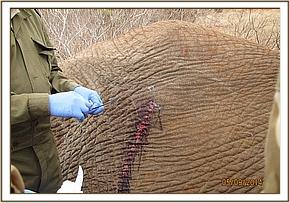
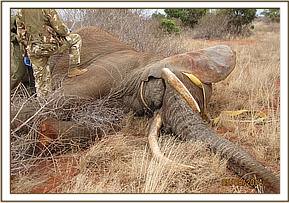

Case #4: Treatment of an injured elephant
Date: 5th September
Species: Loxodanta Africana (African elephant)
Sex: Female
Age: Adult
Location: Power line, Tsavo east
History:
The elephant cow was spotted few minutes after the bull was treated with a big wound on the side of the stomach and pus dripping out. Immediately preparation to treat was mobilized
Immobilization:
Etorphine Hcl(0.98%) (M99®) (Norvatis South Africa (Pty) Ltd) 16mg, in a 1.5 ml Dan - inject dart was prepared. Helicopter darting was carried out. Using a Dan inject® dart rifle the elephant was darted and immobilized after 8 minutes.
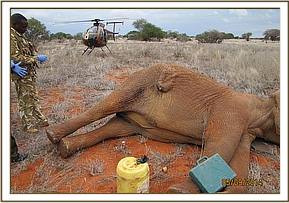
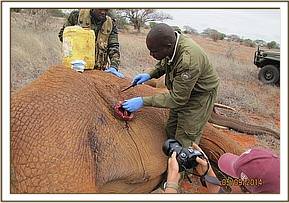

Examination and Wounds management:
The septic wound was cleaned using water mixed with hydrogen peroxide. Oxytetracycline spray (Alamycin® spray) (Norbrook Laboratories Ireland) was also applied. The surgical wounds were also covered with green clay to promote faster healing. The elephant was injected with the following Amoxicillin Trihydrate BP 30000mg (Betamox® LA Norbrook Laboratories Ireland) i.m
and colvasone (Dexamethasone) administered i.v.
Reversal and prognosis:
48 mgs of diprenorphine was used to reverse the anaesthesia and the elephant woke up on its own. Prognosis is good.
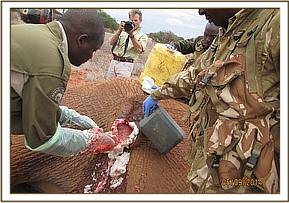
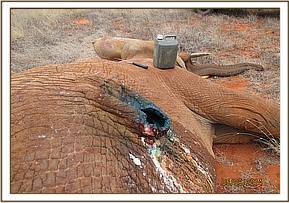

Case #5: Treatment of an injured elephant
Date: 5th September
Species: Loxodanta Africana (African elephant)
Sex: Male
Age: Adult
Location: Aruba area
History:
The elephant was spotted near Aruba dam along Voi River with fresh blood dripping from the ramp area. The huge bull was suspected to have been hit with an arrow. The team moved in swiftly and drugs were prepared for chopper darting.
Immobilization:
Etorphine Hcl(0.98%) (M99®) (Norvatis South Africa (Pty) Ltd) 18mg, in a 1.5 ml Dan - inject dart was prepared. Helicopter darting was carried out. Using a Dan inject® dart system the elephant was darted and was immobilized after 9 minutes.
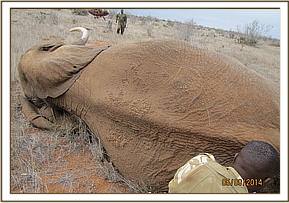
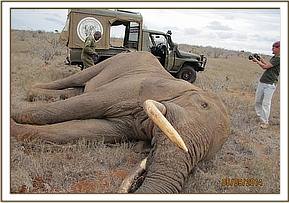

Examination and Wounds management:
The wounded area was examined and a sharp cut wound suspected to be caused by an arrow shot was seen. Surgical exploratory didn’t reveal the deep seated arrow head. The wound was cleaned with hydrogen peroxide and iodine applied. The elephant was injected with the following Amoxicillin Trihydrate BP 30000mg (Betamox® LA Norbrook Laboratories Ireland) i.m
and colvasone (Dexamethasone) administered i.v. Close monitoring was advised.
Reversal:
The anaesthesia was reversed using 24 mgs of diprenorphine mixed with 25 mg of naltrexone and the elephant woke up well.
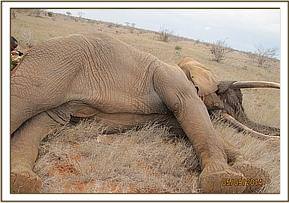
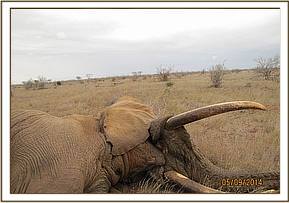

Case #6: Translocation of a problematic elephant from Manyani to Aberdare National parks.
Date: 6th September
Species: Loxodanta Africana (African elephant)
Sex: Male
Age: Adult
Location: Manyani in Tsavo west to Aberdare national park.
History:
The young bull has been causing a lot of problems at the Manyani law enforcement academy and had been previously moved to Mzima springs but returned few days later. A team from Nairobi teamed up with the unit in the operation.
Immobilization:
Etorphine Hcl (M99®) (Norvatis South Africa (Pty) Ltd) 16mg, in a 1.5 ml Dan – inject dart was used to immobilize the elephant by use of a helicopter. The elephant was immobilized after 8 minutes after being driven near an open area by the chopper.

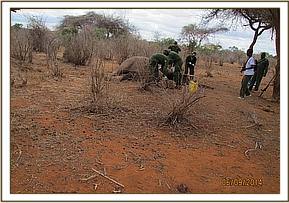

Loading and translocation:
A self loading truck was used to lower the elephant crate to the ground and the elephant loaded into the container while immobilized before he was revived while in the crate. Finally the crane attached to the truck was used to lift the crate loaded with the elephant onto the back of the truck ready for transport.
Revival:
The anaesthesia was reversed using 48 mgs of diprenorphine injected intravenously. 50 mgs of azaperone was also administered to calm down the elephant while on transit. The team from Nairobi left and successfully released the elephant in Aberdare National Park.



Case #7: Treatment of injured elephant bull
Date: 8th September
Species: Loxodanta Africana (African elephant)
Sex: Male
Age: Adult
Location: Satao, Tsavo east
History:
Several huge elephant bulls were sited within Satao area of Tsavo east with arrow wound injuries. The vet team together with two aircrafts that included a helicopter descended in the area and after a shot search several of the candidates were spotted.
Immobilization:
Etorphine Hcl (M99®) (Norvatis South Africa (Pty) Ltd) 18mg, in a 1.5 ml Dan – inject dart was used to immobilize the elephant by use of a helicopter. The elephant was immobilized in 7 minutes.
Examination and Treatment:
The wounded are was examined and found to be healing leaving a scar on the left flank and didn’t require much attention. Dexamethasone was administered.
Reversal was by use of 60 mgs of diprenorphine Hcl in the ear vein.
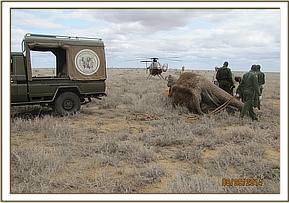
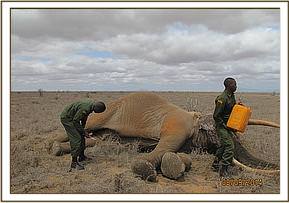

Case #8: Treatment of an elephant bull
Date: 8th September
Species: Loxodanta Africana (African elephant)
Sex: Male
Age: Adult
Location: Satao, Tsavo east
History:
Several huge elephant bulls were sited within Satao area of Tsavo east with arrow wound injuries. The vet team together with two aircrafts that included a helicopter descended in the area and after a shot search several of the candidates were spotted.
Immobilization:
Etorphine Hcl (M99®) (Norvatis South Africa (Pty) Ltd) 18mg, in a 1.5 ml Dan – inject dart was used to immobilize the elephant by use of a helicopter. The elephant was immobilized in 8 minutes.
Examination and Treatment:
The wound was examined and found to be on the right side of the stomach and was on the process of healing. The suspected arrow wound was cleaned using hydrogen peroxide mixed with water and doused with tincture of iodine. Dexamethasone was administered intravenously.Reversal was by use of 60mgs of Diprenorphine Hcl in the ear of the elephant.
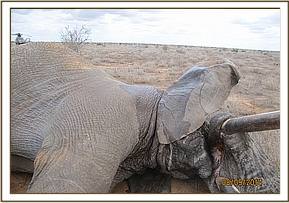
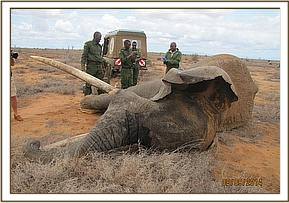
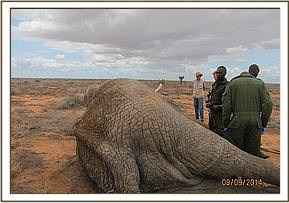
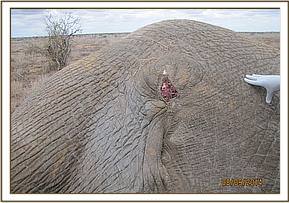
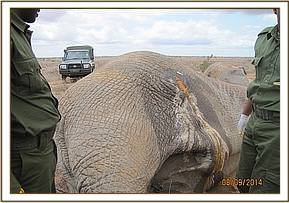

Case #9: Treatment of an elephant bull
Date: 8th September
Species: Loxodanta Africana (African elephant)
Sex: Male
Age: Adult
Location: Satao, Tsavo east
History:
Several huge elephant bulls were sited within Satao area of Tsavo east with arrow wound injuries. The vet team together with two aircrafts that included a helicopter descended in the area and after a shot search several of the candidates were spotted.
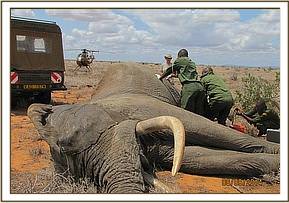


Immobilization:
Etorphine Hcl (M99®) (Norvatis South Africa (Pty) Ltd) 18mg, in a 1.5 ml Dan – inject dart was used to immobilize the elephant by use of a helicopter. The elephant was immobilized in 12 minutes.
Examination and Treatment:
There was a wound on the left hind limb near the ramp with a second wound at the left inguinal area. The wound were enlarged and necrotic tissues mixed with pus removed from under. The cavity left behind by dead tissues was cleaned using hydrogen peroxide mixed with water, doused with tincture of iodine and covered with green clay. Long acting Amoxicillin and Dexamethasone administered parenterally.
Anaesthesia reversal:
Reversed by administration of 60 mgs of diprenorphine hcl administered intravenously through the ear vein.
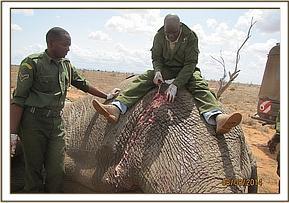
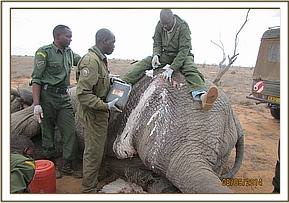

Case #10: Treatment of an injured elephant bull
Date: 8th September
Species: Loxodanta Africana (African elephant)
Sex: Male
Age: Adult
Location: Satao, Tsavo east
History:
Several huge elephant bulls were sited within satao area of Tsavo east with arrow wound injuries. The vet team together with two aircrafts that included a helicopter descended in the area and after a shot search several of the candidates were spotted.
Immobilization:
Etorphine Hcl (M99®) (Norvatis South Africa (Pty) Ltd) 18mg, in a 1.5 ml Dan – inject dart was used to immobilize the elephant by use of a helicopter. The elephant was immobilized in 10 minutes.
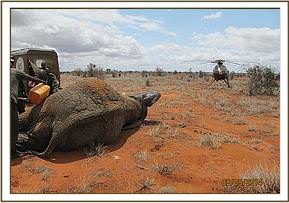


Examination and Treatment:
There was a wound was on the upper part of the left hind limb on the lateral aspect. The wound was oozing pus but not swollen. The wound was cleaned using hydrogen peroxide mixed with water and doused with tincture of iodine. Wetted green clay was used to cover the wound. Long acting antibiotics and anti-inflammatory drugs were administered parenterally.
Anaesthetic reversal:
Reversed by administration of 60 mgs of diprenorphine hcl administered intravenously through the ear vein.

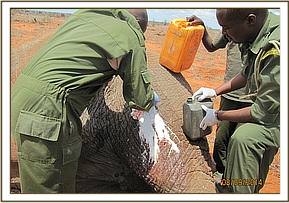

Case #11: Clinical assessment of an orphan attacked by Hyenas
Date: 10th September
Species: Loxodanta Africana (African elephant)
Sex: Male
Age: Young
Location: Ithumba stockades
History:
The young elephant orphan was reported to have been attacked by hyenas near Ithumba stockades and rescued by the stockade staff. The vet was airlifted to Ithumba from Voi.
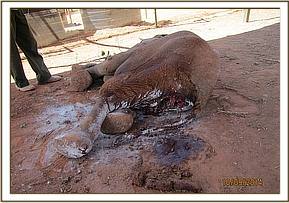
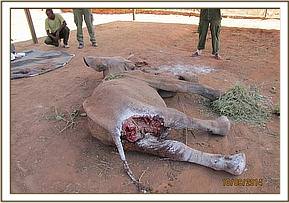

Examination and management:
The general exam revealed an emaciated young elephant with body score of 2/5. He was already recumbent and several attempts to lift him up proved futile. Mucous membranes were pale with very cold extremities a sign of massive blood loss. The perineal area had a huge lucerations caused by Hyena attacks. 2 mgs of etorphine were injected intravenously to reduce pain. The prognosis of healing being very poor, a decision euthanize was made to end his suffering.
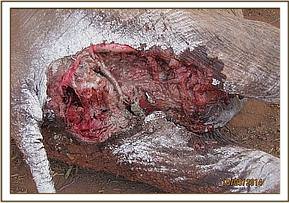
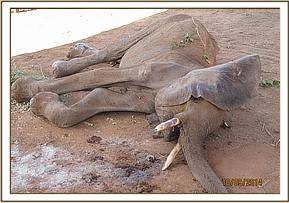

Case #12: Treatment of an injured elephant bull
Date: 12th September
Species: Loxodanta Africana (African elephant)
Sex: Male
Age: Adult
Location: Ithumba
History:
The big bull was seen foraging near Ithumba offices together with former orphans with an arrow wound on the left side of the abdominal wall. Being in a group of friendly former orphans, darting was easy.
Immobilization:
Etorphine Hcl (M99®) (Norvatis South Africa (Pty) Ltd) 18mg, in a 1.5 ml Dan – inject dart was used to immobilize the elephant on foot. The elephant was immobilized in 11 minutes.
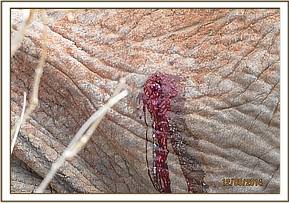
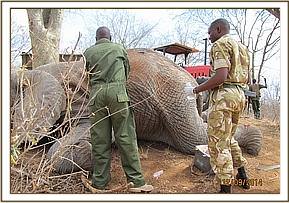

Examination and Treatment:
The elephant fell on sternal recumbency and was blocked by a tree on one side and a ditch on the other. A decision to attend to him and reverse the anaesthesia fast was the most feasible. The arrow head was removed quickly and wound cleaned and tincture of iodine applied.
Anaesthesia reversal:
Quick reversed by administration of 24 mgs of diprenorphine and 25 mgs of naltrexone both intravenous.
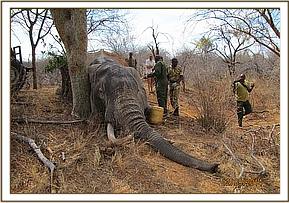
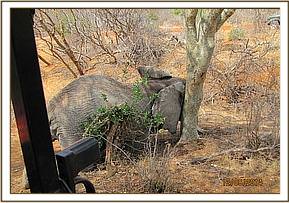

Case #13: Treatment of two security dogs in Ithumba
Date: 12th September
Species: Canine
Sex: Male and female
Age: Adult
Location: Ithumba, Tsavo east
History:
The two dogs had been reported sick with the male manifesting signs of orchitis externa and the bitch with impaction and difficulty in passing stool.
Examination and treatment:
General examination confirmed the diagnosis and treatment was immediately instituted. The case with orchitis was treated with 4 cc of long acting Amoxicillin and 5 cc of dexamethasone both administered intra muscularly. The case with impaction was given 10 cc of liquid paraffin after meals. Both cases responded well.
Case #14: Treatment of an injured elephant bull
Date: 15th September
Species: Loxodanta Africana (African elephant)
Sex: Male
Age: Adult
Location: Satao-kulalu area, Tsavo east
History:
Several huge elephant bulls were sited within satao area of Tsavo east with arrow wound injuries. The vet team together with two aircrafts that included a helicopter returned to the area and after a shot search several injured elephants were spotted. This huge tusker had an injury on the left hind leg and was in a group of 7 other huge bulls.

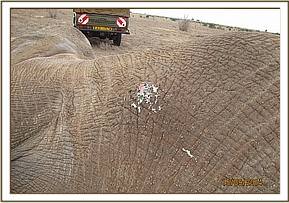

Immobilization:
Etorphine Hcl (M99®) (Norvatis South Africa (Pty) Ltd) 18mg, in a 1.5 ml Dan – inject dart was used to immobilize the elephant by use of a helicopter. The elephant was immobilized in 10 minutes.
Examination and Treatment:
There was a wound was on the upper part of the left thoracic cage. The wound was oozing pus but and slightly swollen. The wound was cleaned using hydrogen peroxide mixed with water and doused with tincture of iodine. Wetted green clay was used to cover the wound. Long acting antibiotics and anti-inflammatory drugs were administered parenterally.
Anaesthetic reversal:
Reversed by administration of 60 mgs of diprenorphine hcl administered intravenously through the ear vein.
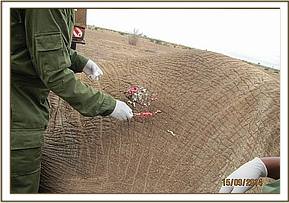
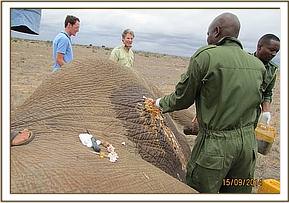

Case #15: Treatment of an elephant bull
Date: 15th September
Species: Loxodanta Africana (African elephant)
Sex: Male
Age: Adult
Location: Voi River near Satao, Tsavo east
History:
Several huge elephant bulls were sited within Satao area of Tsavo east with arrow wound injuries. The vet team together with two aircrafts that included a helicopter returned to the area and after a shot search several injured elephants were spotted.
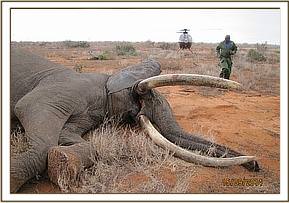
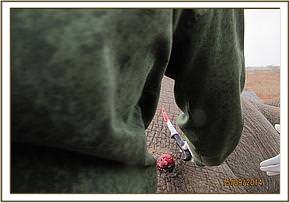

Immobilization:
Etorphine Hcl (M99®) (Norvatis South Africa (Pty) Ltd) 18mg, in a 1.5 ml Dan – inject dart was used to immobilize the elephant by use of a helicopter. The elephant was immobilized in 10 minutes.
Examination and Treatment:
There was a wound on the upper part of the right thigh. The wound was reddish and appeared fresh but closer examination revealed a growth. The growth was cut off and the wound was cleaned using hydrogen peroxide mixed with water and doused with tincture of iodine. Wetted green clay was used to cover the wound. Long acting antibiotics and anti-inflammatory drugs were administered parenterally. The huge bull is one of the iconic big tuskers still remaining in Tsavo conservation area.
Anaesthetic reversal:
Reversed by administration of 60 mgs of diprenorphine hcl administered intravenously through the ear vein.
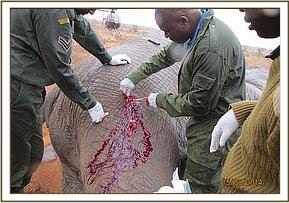
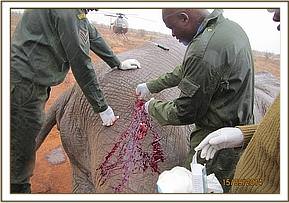

Case #16: Translocation of a buffalo
Date: 17th September
Species: African buffalo (Syncerfus caffer)
Sex: Male
Age: Adult
Location: Komboyo to Tsavo River (Rhodesia) in Tsavo west
History:
The adult female buffalo was moved from Nairobi orphanage due to congestion at the facility. The two Buffaloes were translocated and released near Komboyo park headquarters and one of them entered the park headquarters compound and become a threat to staff and families residing in the park and had to be moved.
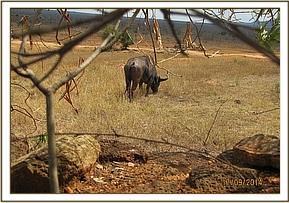
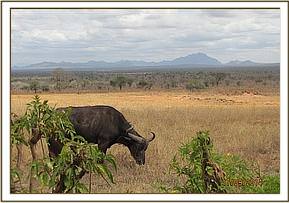

Immobilization and transport:
The buffalo was immobilized using 7 mgs of Etorphine mixed with 60 mgs of Xylazine hydrochloride and went down in 12 minutes. An animal stretcher was used to load the buffalo unto a land cruiser pickup and transported to Rhodesia area along Tsavo River where it was offloaded and given antibiotic and multivitamin covers before anaesthesia reversal.
Anaesthetic reversal:
Anaesthesia was reversed by injection of 24 mgs of Diprenorphine hcl and 2.5 mgs of Atipemazole hcl administered intravenously via the jugular vein.
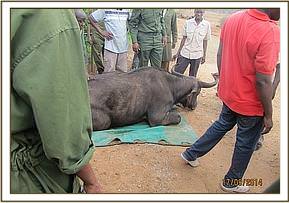
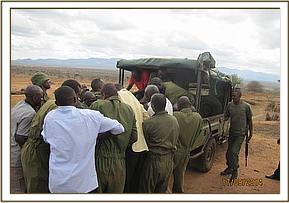

Case #17: Treatment of a piglet
Date: 22nd September
Species: Warthog
Sex: Male
Age: Piglet
Location: Park headquarters, Tsavo east
History:
The warthog piglet was rescued after sustaining deep puncture wound from an attack by eagle predators near Galana ranch east of Tsavo east national park. The piglet was feeding well on milk.
Examination and treatment:
The piglet had deep cut wounds on both sides of the shoulder caused by Eagle claws. The wounds were washed with normal saline and crystalline penicillin splashed. Nylon sutures were used to close the wounds using an interrupted suture pattern. Anti inflammatory and antibiotics were also administered.
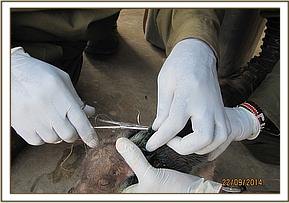
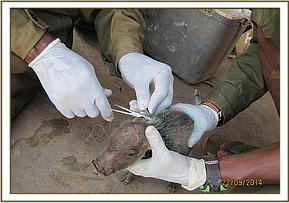


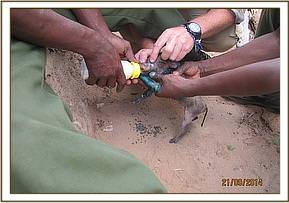

Case #18: Rescue of a sickly elephant calf
Date: 22nd September
Species: Loxodanta Africana (African elephant)
Sex: Female
Age: Calf about 3 years old.
Location: Ngutuni, Tsavo east
History:
The young elephant was reported being recumbent near a water hole along Mzima pipeline by Ngutuni lodge staff. She was unable to wake up let alone move.
Immobilization and transport:
The elephant was immobilized by injection of 2 mgs of etorphine hcl into the ear vein. Lots of water was used to cool her. The body condition was estimated at 2/5 as muscle wasting was evident. The calf was loaded onto a truck and taken to Voi stockade for further medical attention. Intravenous dextrose solution managed to stabilise the calf upon arrival at the stockade. She succumbed two days later and the diagnosis was given as starvation. Cases of mortalities in young calves that are no longer suckling occur often in the parks especially during the dry season when forage and water is scarce.
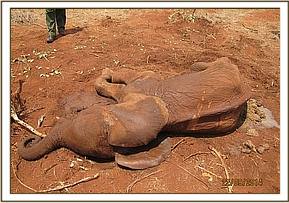

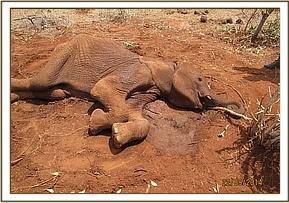
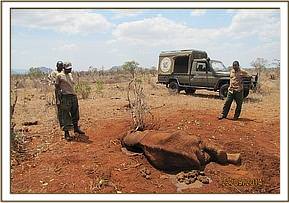
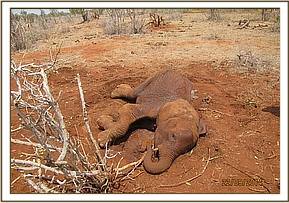

Case #19: Lion collaring exercise
Date: 27th September
Species: Lioness (Panthera leo)
Sex: Female
Age: Adult (6 years)
Location: Kuku ranch (Maasai wilderness conservation trust
History:
Kuku ranch is an expansive community land belonging to the Maasai community located west of Tsavo west national park and also bordering Chyulu national park and Mbirikani group ranch. It forms part of the Tsavo-Amboseli ecosystem with abundant wildlife species including lions. The maasai being pastoralists where they keep livestock as the main economic activity, conflict with wildlife especially predators is a major problem. The maasai wilderness conservation trust (MWCT) came with a programme to collar some lions with satellite linked collars in order to monitor the movements and mitigate of the predation problem.
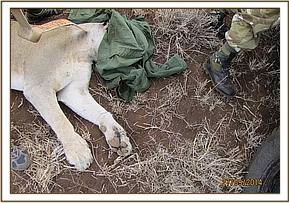
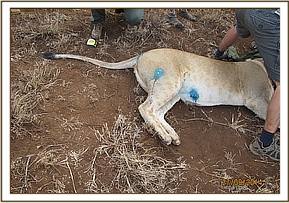

Immobilization and collaring:
The exercise was undertaken at night unsuccessfully through call ups for two days. On third day a pride spotted near kuku plains and immobilization was using 300mgs of Ketamine Hcl mixed with 4 mgs of meditomidine hcl. A repeat dart was used to ensure effective anaesthesia is achieved. Several samples were taken including blood and tissue samples and the collar well fitted and mounted around the neck with screws. Antibiotic and multivitamins were administered as cover.
Anaesthesia reversal:
2.5 mgs of Atipemazole Hcl was injected intramuscularly and a team left to keep watch until the lioness wakes up.

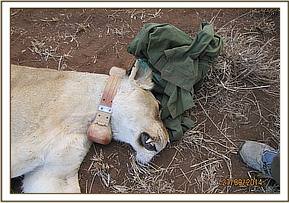

Case #20: Treatment of an elephant
Date: 30th September
Species: Loxodanta Africana (African elephant)
Sex: Female
Age: Young (about 5 years old)
Location: Lualenyi ranch in Taita ranches
History:
The young elephant cow was reported to be lame with a swollen front leg near Lualenyi ranch with the Taita ranches.
Immobilization and Treatment:
Etorphine Hcl (M99®) (Norvatis South Africa (Pty) Ltd) 12 mgs, in a 1.5 ml Dan – inject dart was used to immobilize the elephant. The elephant was immobilized in 6 minutes.
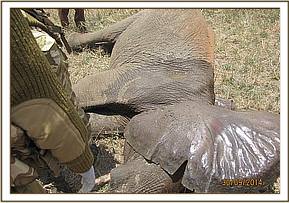


Examination and Treatment:
There was a clear snare wound around the right front leg few inches from the foot. The wound was cleaned using hydrogen peroxide mixed with water and doused with tincture of iodine. Wetted green clay was used to cover the wound. Long acting antibiotics and anti-inflammatory drugs were administered parenterally. Green clay was used to cover the wounded site.
Anaesthetic reversal:
24 mgs of Diprenorphine mixed with 25mgs of Naltrexone administered intravenously through the ear vein.
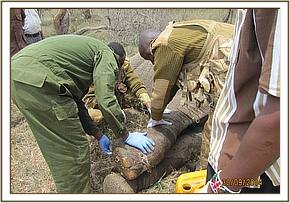


Case #21: Treatment of injured elephant bull
Date: 30th September
Species: Loxodanta Africana (African elephant)
Sex: Male
Age: Adult
Location: Lualenyi ranch in Taita ranches
History:
The elephant bull was seen limping nearby after the treatment of young female nearby in Lualenyi ranch. It is suspected to have been shot with a bullet and walked with a lot of pain.
Immobilization and Treatment:
Etorphine Hcl (M99®) (Norvatis South Africa (Pty) Ltd) 18 mgs, in a 1.5 ml Dan – inject dart was used to immobilize the elephant. The elephant was immobilized in 7 minutes.
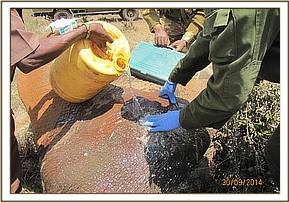
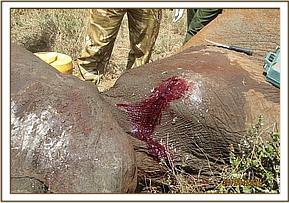

Examination and Treatment:
The area around the left shoulder joint had an open penetrating wound. On probing the wound was deep and affected the shoulder joint near the humero-scapula area. The wound was cleaned using normaline saline and doused with tincture of iodine. Oxytetracycline spray was sprayed and covered with green clay. Long acting Amoxicillin antibiotic and dexamethose injected to reduce inflammation and bacterial infection.
Anaesthetic reversal:
24 mgs of Diprenorphine mixed with 25mgs of Naltrexone administered intravenously through the ear vein.



Other cases reported
- An elephant calf was rescued from Satao area on 3rd September and airlifted to Voi stockade for care.
- A week old elephant calf was rescued near Mzima pipeline area of Tsavo east after falling into a deep water hole and taken to Nairobi orphanage.
- Two other elephant bulls were treated in Satao area of Tsavo east on 23rd September by the Amboseli vet unit
Conclusion and acknowledgement
Cases of arrow injuries especially in elephant bulls have increased tremendously due to the dry spell that forced many animals to venture far and wide. The arrow poaching attempts are serious threats to the lives of the huge bulls in the ecosystem. Each case of treatment in attempted poaching incidence is promptly reported to the security teams for follow up. The unit will continue responding to cases as they are reported in the region.
The unit would like to appreciate the support of its sponsors ViER PFOTEN through the David Sheldrick Wildlife Trust (DSWT) for their continued support that has enabled us respond promptly to wildlife vet reports. The addition of aircraft especially the helicopter has greatly improved the response time. We also thank Kenya Wildlife Service through the Assistant director Tsavo conservation area and the head, veterinary and capture services department for their support. Lastly I would like to thank the skyvet team in Nairobi and the Amboseli vet unit for their assistance while the unit was away